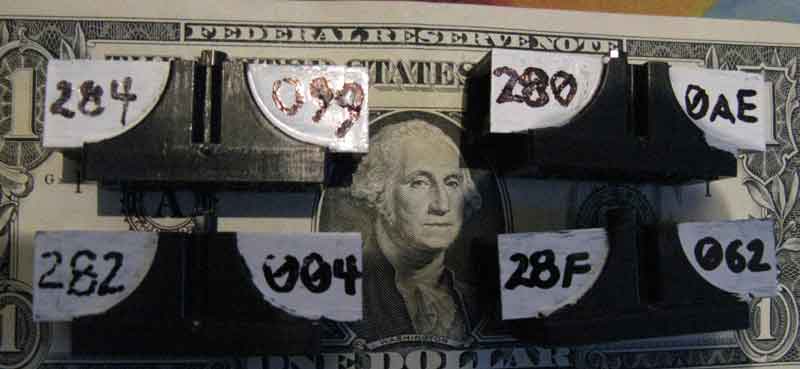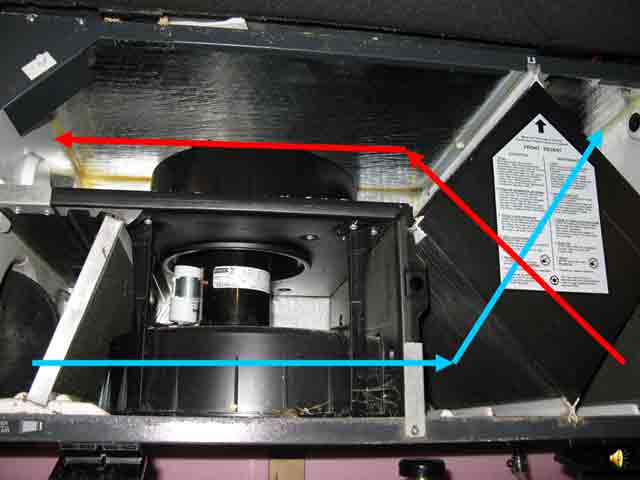- Home
- Deceptions
- Solar
- Thermal Audit
- Ventilation
- Sensors
- Governance
- Environment
- Reference
- Contact
- News
1-Wire Venmar Heat Exchanger Monitor
note: I do not recommend the the Venmar Constructo heat exhchanger, click here to see why. However, since one came with my home, I use it for experiments. This experiment only looks at the temperatures in the chamber. I also made a on-demand ventilation controller that measures the CO2 you breath out here.
1-wire is technology from Maxim (formerly Dallas Semiconductor) that allows sensors (humidity, temperature, barometric pressure, wind speed or just about anything else you can dream up) to be connected to a computer cheaply using things like telephone wire. They don't need power supplies either, they get the little (amazing little) power they need from the computer.
Wiring sensors into a Venmar Constructo Heat Exchanger, Heat Recovery Ventilator
Purpose:
To measure chamber temperatures to see how the device is performing under various weather condtions. By adding a 1-wire based carbon dioxide sensor and particle counter (not for sale yet), a high performance on-demand ventilation system could be developed which only exchanges air when it makes sense to do so.
Methodology:
The iButtonLink temperature modules are small black boxes with a telephone jack in each end (RJ-11). Here they have been painted with white-out and the first and last three digits of their serial numbers have scribbled on with a permanent marker. If you don't do this, you will have a hard time identifying them later.
I ran a utility to identify them one by one (Dallas/Maxum 1-wire viewer) and found the following.
2804F3A7010000AE Exhaust to Outside 18B20:programmable resolution digital thermometer
282CF9A701000004 Exhaust from Building 18B20:programmable resolution digital thermometer
28F69EB901000062 Fresh from Outside 18B20:programmable resolution digital thermometer
284B2DA801000099 Fresh Air to Building 18B20:programmable resolution digital thermometer
Alternately, you can use the w1find utility that comes with w1retap. Here the sensors are laid out on a dollar bill.

The picture below is the heat exchanger before the sensors were installed. The arrows indicate the direction of the air flow through the unit. The diamond shape cube is the "core". Imagine a cube made from layers of corrugated cardboard, with every layer rotated 90 degrees relative to the previous layer. The little corrugated channels line up with the colored arrows in the diagram below. In other words, the air following the blue arrow can travel through every second layer of corrigated material in the core. The air flow is separated by the layers, and because they are close together, there is a great deal of heat transfer. Additionally, warm air from the house will condense inside the colder core releasing latent heat, and requiring a water drain at the bottom of the unit. The latent heat of condensation is the exact opposite of evaporative cooling (e.g. getting cold when sweat evaporates).

The next step is to install some sensors in the heat exchanger. The sensors on the sides are attached with 3M double sided foam tape, while the one at the top is attached with a tie wrap. Holes were drilled for the telephone wire and the connectors were crimped on afterwards so that the holes could be as small as possible. Telephone wire often has 4 conductors, but only two are needed for this applicaton.

Here is a close up of one of the sensors. You can seal the hole with some silicone sealant, but in this case it was pretty tight.

Next step is to reinstall the fan unit and heat exchanger core. I am showing this here because of a pet peeve of mine. This is the third unit in five years, and the assemblies cost over $300 each. Motors like these need to be removable, replaceable, and probably with an oil port. There is a label on the unit that says "New Maintenance Free Motor", they just neglect to mention that the life span is very short. Heat exchangers are already difficult to justify financially because of the present value of the installation costs exceed the future savings in most cases, and adding another $300 in regular fan replacements on top of the electric power costs borders on the ridiculous.

Venmar, if you want people to recommend your products, increase the warranty to 10 years and offer free replacements, then redesign it to actually last 10 years. Incidentally, the unit in the house next to this one had an identical unit die a few weeks later and the houses were built in the same season. So that is five fans between two houses and climbing. Venmar, are you listening? How come you don't have a customer service e-mail address and ask people to write you via snail mail?
The picture below is the assembly that is replaced in its entirity every time the motor bearings sieze. This is great for the service technician (two screws are all that need to be removed) but terrible for the customer that gets a huge repair bill.

When the telephone wire comes back to the computer, it has to be plugged into a 1-wire interface. Here is an example on one of our test systems before the wires were re-routed and tidied up. This computer is about as tall as a dollar bill. You can find small computers like this by searching for pico-ITX. The telephone wire in the middle of the 5 jack block at the left goes to the heat exchanger. The block is in turn plugged into the translucent blue adapter (Maxim/Dallas DS2490-1 USB adapter). An iButtonLink adapter would work better -- having this many parallel circuits tied to a single DS2490 adaptor oven returns 80C as the temperature (a bogus value due to a read failure).

Now for some measurements. First the air-flow. A Fluke model 922 Airflow/Micromanometer was attached to a pitot tube is used to measure the air flow in the main duct sending fresh air to the house. A small hole was drilled to insert the tube and later patched with a square of metallic foil tape.

Air flow was measured at 225 cubic feet per minute, which is a little higher than the Venmar's specification. This is also more than double what ASHRAE guidelines suggest, so I installed a timer to cycle two hours on, and two hours off. Two hours was chosen because if ventilation systems are off for more than three hours, particles settle and you end up having to pump more air to recover.
Now we get to the interesting part. What do you expect to see? Do you think the that the stale inside air will drop the same number of degrees that the incoming outside air will rise.

Analysis: The graph above shows the four chamber temperatures. The cycles are two hours long because of the timer. Notice that the fresh air from outside (the blue line, and it is close to freezing) warms up many more degrees (fresh air to building, orange) than the exhaust air cools down. This is due to the energy from condensation. Warm air inside the building is moist and condenses on the cold core, releasing extra heat.
We are in the process of experimenting with realistic local conditions (the test above is for a pretty cold house -- heat was set to 10C) to see if incoming fog on cold damp days causes enough evaporative cooling to negate the gains from condensation in the core, and are looking at particle counts and CO2 concentrations as inputs to an intelligent controller for these kinds of devices.
In the meantime, have fun experimenting and make sure you throttle these units back to give you only the air flow needed (consult the ASHRAE handbook in our links section). It will save you a lot of money in lost heat and wasted electricity.
Software: The easiest way to collect data from these sensors is with w1retap. This excellent and free 1-wire logging software is available at Source Forge. The 1-wire viewer is available from Maxim.
Hardware: Any temperature sensor will do. I like the robust sensors from iButtonLink.
Venmar Constructo 2.0 specification sheet.
VENMAR AVS ERV CONSTRUCTO 2.0 QUATTRO
Part #45115
REPAIRS AND MAINTENANCE
Venmar AVS ERV Constructo Quattro modular design makes it
possible to remove all mechanical parts in less than 5 minutes. (to help the service companies quickly remove the guts and sell you and entire fan assembly rather than enable them to fix the motor. The motor is not easily removable from the fan assembly.) The low power consumption PSC motor is permanently
lubricated (when the lubricant fails, it simply seizes up. Low power in this context just means small, not efficient - PCS motors are wasteful). Even better, the entire motor sub-assembly can
be removed in less than a minute for easier maintenance. (this is true).
WARRANTY
The Venmar AVS ERV Constructo Quattro is protected by a
2-year warranty on parts only. (fans only last two years which is why we only give two years). The energy recovery core is covered by a 5-year warranty.
